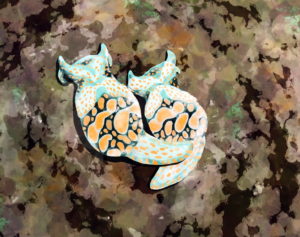
Cymbal bubble snails in Nihoa tide pools inspired this drawing by local artist and marine scientist, Nimz.
December 18, 2020
This week I received an early Christmas gift from friend, Ilana Nimz, a local biologist and artist who helped me design the Kolea Count T-shirts. The gift was a print of Nimz’s (she goes by her last name only) lovely drawing of a pair of cymbal bubble snails.
The present left me momentarily speechless. I’ve never seen these creatures in real life, nor could I recall their name.
“Bubble shells,” Nimz said, when I hesitated.
Ah, yes. Bubble shells. I know them. Sort of.
Bubble snails are a group of marine mollusks partway between sea slugs—snails without shells—and regular snails that build hard, calcium carbonate shells. Bubble snail shells are thin, fragile, and too small for the whole animal to fit inside.
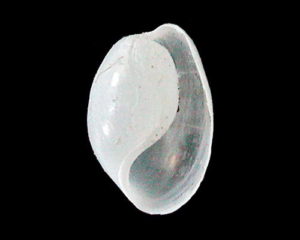
A cymbal bubble snail’s shell. From Sea Slugs of Hawaii by Cory Pittman and Pauline Fiene, http://bit.ly/34pAWdT
Cymbal bubble snails grow about an inch long, with a shell about 1/3rd inch long. In the cymbal snail, so-called after the species name, cymbalum, meaning the musical instrument, cymbals, the shell is clear and colorless. As a result, the green, white, and orange colors of the snail’s body show through in patterns that practically plead for an artistic rendering.
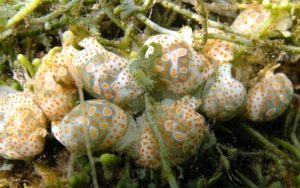
Photos from Sea Slug Forum, www.seaslugforum.net/find/19447, Reunion Island, Indian Ocean. Photo by Alain Barrére.
Bubble snails are common in some areas of Hawaii, and (I’ve heard) multiply like crazy in tide pools and reefs, sometimes showing up by the dozens. Because they’re hermaphrodites, mating sometimes appears as chains of connected animals (above photo). This is why I prefer snorkeling as opposed to scuba diving – some of the most amazing marine animals live only a foot or two deep.
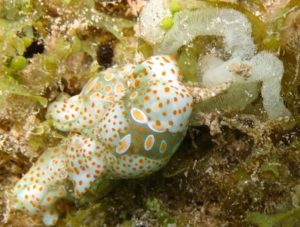
Two cymbal bubble snails laying eggs , the white tubes on the right. (Photo source same as above.)
The cymbal snail produces a chemical that makes the snail taste bad to potential predators. This may be the result of the cymbal bubble snail’s diet of the seaweed called Lyngbya. We in Hawaii call Lynbya majuscula stinging limu, because its toxin causes a rash on human skin. Cymbals also graze on green algae.
A close relative of the cymbal snail is called the swollen bubble snail, an even smaller snail at 3/4ths inch long. This carnivorous snail eats worms. Although local sources report that bubble snails are common, I have found only one, pictured below, in all my years in the ocean. Clearly, I’ve not been looking properly.
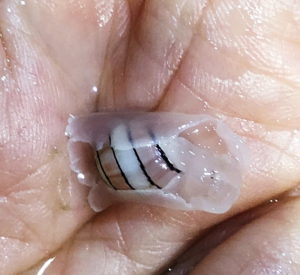
A swollen bubble snail, Hydatina amplustre, in my hand, found in shallow water off Oahu’s North Shore. The two black dots on the right are the snail’s eyes. ©Susan Scott
Check out this short National Geographic video to see a bubble snail in all its glory: http://bit.ly/2KDYFQj
Cymbal, swollen, and other bubble snail species range throughout the Pacific and Indian Oceans in warm tropical and subtropical waters.
Look for these striking snails in wintertime on Hawaii’s reef flats and tidepools. You might see me there. With this pretty present on my office wall to remind me of their special beauty, bubble snails will be front and center on my mind when I’m poking around tide pools.
Thank you, Nimz, for a gift that inspires me to stay shallow and think small.
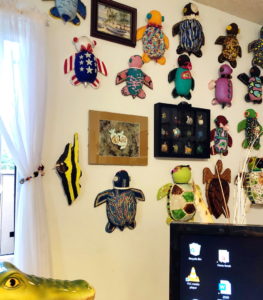
Nimz’s bubble snails are a great addition to my office wall.